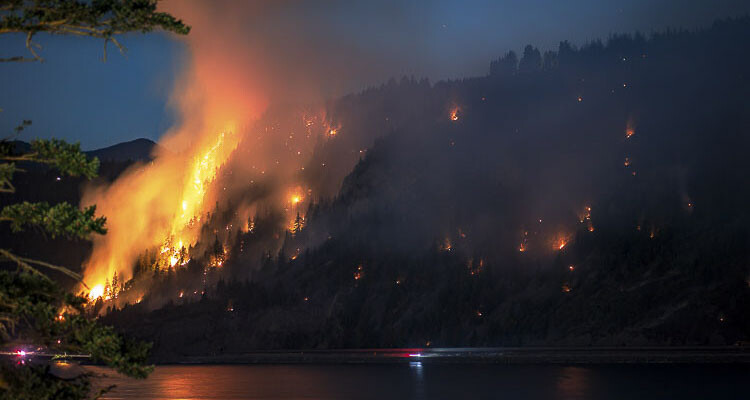
Despite the ongoing fire danger and consequences, prescribed burns are used sparingly on federal lands in the mountain states including Washington
Madilynne Clark
Mountain States Policy Center
As the summer heat intensifies, peak fire season is migrating north, but the critical practice of prescribed burning continues to avoid the western states. Oregon (4), Idaho (5), Montana (9) and Washington (10) suffered more acres burned than most of the United States in 2022, all ranking in the top ten states of acreage burned in 2020 to 2022 (rank refers to 2022). Utah (21) and Wyoming (22) trailed slightly behind. Despite the ongoing fire danger and consequences, prescribed burns are used sparingly on federal lands in the mountain states.

In 2022, with millions of acres burning, Montana (32), Washington (35), Idaho (36), Oregon (37), Utah (42) and Wyoming (45) ranked in the bottom half of the United States for prescribed burning on public lands, average 0.08% of public lands treated with prescribed burning. On the other hand, states in the Southeast like Alabama and Georgia, treated over 40% of public lands with prescribed burning and experienced a much milder wildland fire season, ranking 19th and 24th respectively for total acres burned.
Prescribed burning is underutilized in the mountain states because the federal government owns the majority of public lands. Tribal and state agencies in the mountain states are increasing the funding for prescribed burns, but the area managed by these authorities is much smaller compared to federal lands. For example, 61.6% of Idaho lands are owned by the federal government and only 8.8% are owned by the state.
On the other hand, the Southeast has very little public land, and the states own the majority of the public land. This has allowed the southern states and tribal governments to quickly adopt necessary prescribed burning practices.

The federal government’s feet dragging on prescribed burning keeps the mountain states from many positive benefits. Historically, Native American tribes worked with nature to encourage fires where they were needed, managing fuel loads and deterring extreme fire behavior. However, a century of fire suppression tactics has increased the fuel load and combined with hotter and drier weather to create the extreme fire seasons the mountain states experience annually.
Despite the southern area of the United States burning more acres than the ten-year average in 2022, there were no significant fire incidents in Alabama and Georgia. Significant fire incidents are fires that burn over 40,000 acres and are common in the western states and Alaska. In fact, from 2018 through 2022, Georgia and Alabama had no serious wildfires resulting in death or serious injury or causing property damage. During this time California experienced 83 serious fires, Washington 43, and Idaho 27.
The southern United States and tribal communities were the first to re-adopt prescribed fires to manage fuel loads and prevent significant fires. Tribes have been able to work within their smaller government systems to adopt prescribed burning practices and the results have returned once high-risk forests to healthier, historically correct states.
This widespread adoption of prescribed fires was not passively attained in the Southeastern United States. In the 1990s, the southern states experienced repeated seasons of extreme wildfires. Lawmakers passed legislation to increase training and ease permitting for burns. Residents of the southeast tolerate the smoke from prescribed burns, understanding the resulting benefits and fire prevention.
But for federal owned lands the battle is more cumbersome. Overwhelmed by red tape, lacking in generational knowledge of prescribed burns, and inundated with complaints of smoke inhalation and fire risk, federal lands still pursue mostly a fire suppression strategy. Fire resource budgets are almost entirely dedicated to suppressing fires no matter location or cause, and prescribed fires are rarely budgeted.
Frustrating matters, the Environmental Protection Agency proposed a rule this spring for the Clean Air Act that would further regulate smoke particles. The rule could add additional complications to the use of prescribed burning throughout the country. California legislators have urged the EPA to support prescribed burning, not further the difficulty.
Federal lands in the mountain states have a long way to go before they catch up on the long list of unhealthy forests. Millions of acres need treated but only thousands of acres are treated annually. It will take years of prescribed burns and harvesting to restore the western lands. The Biden Administration’s delegation of $2 billion for prescribed burning practices in 2022, will not go far enough to remediate the situation. Estimated prescribed fire costs are between $100 and $1,000 per acre. In California there are an estimated 10-30 million acres that would benefit from prescribed burning, not to mention the millions of acres throughout the other western states.

Federal officials need to act now to adopt prescribed fire practices on a scale that can provide an actual solution to the growing pressure of unhealthy forests and excessive fuel loads. Policies that would improve the use of prescribed fires include:
- Encouraging federal land agencies to request federal funding for sufficient fuel reduction projects and dedicating state-level funding
- Ensure the EPA’s proposed Clean Air Act rule will not hinder the use of prescribed burns
- Easing the permitting process so burn permits can be issued quickly (Idaho and Wyoming require longer than a day for authorization)
- Offer prescribed burn manager certification (only Washington offers it at this time)
- Adopt a right-to-burn act, allowing private landowners to burn on their own land (only permitted in Oregon and Utah).
U.S. Senator Jim Risch, R-Idaho said in 2021, “The time has long passed to slowly chip away at our forest health issues and hope the problem will improve by next year. Idaho is 40% forestland, the vast majority of which is managed by government entities, and decades of insufficient forest management have left millions of these acres vulnerable to the kinds of catastrophic fires that have increasingly become the norm in the West.”
Unlike wildfire, new policies are difficult to move uphill, but prescribed burning is worth the push. Western legislators have submitted multiple policies to remediate the western landscape, but progress has been sparse. The iconic forests of the mountain states need healthy, well managed fire to thrive. Prescribed burning needs rapid and significant adoption to be beneficial to the mountain states’ scenic region.
Madilynne Clark is a policy analyst at the Western States Policy Center.
Also read:
- POLL: Why did voters reject all three tax proposals in the April 22 special election?Clark County voters rejected all three tax measures on the April 22 special election ballot, prompting questions about trust, affordability, and communication.
- Opinion: The war on parental rightsNancy Churchill argues that Olympia lawmakers are undermining voter-approved parental rights by rewriting key legislation and silencing dissent.
- Opinion: An Earth Day Lesson – Last year’s biggest environmental victories came from free marketsTodd Myers argues that Earth Day should highlight free-market solutions and grassroots innovation as more effective tools for environmental stewardship than top-down mandates.
- Opinion: Time to limit emergency clauses and give voters a choiceTodd Myers urges the governor to remove emergency clauses from bills that appear intended to block voter input rather than address real emergencies.
- Letter: C-TRAN Board improper meeting conductCamas resident Rick Vermeers criticizes the C-TRAN Board for misusing parliamentary procedure during a controversial vote on light rail.










